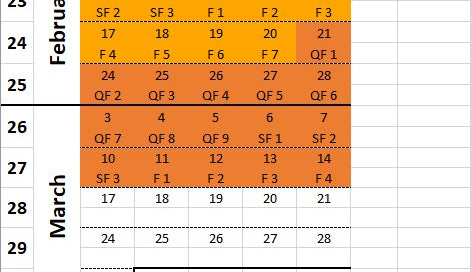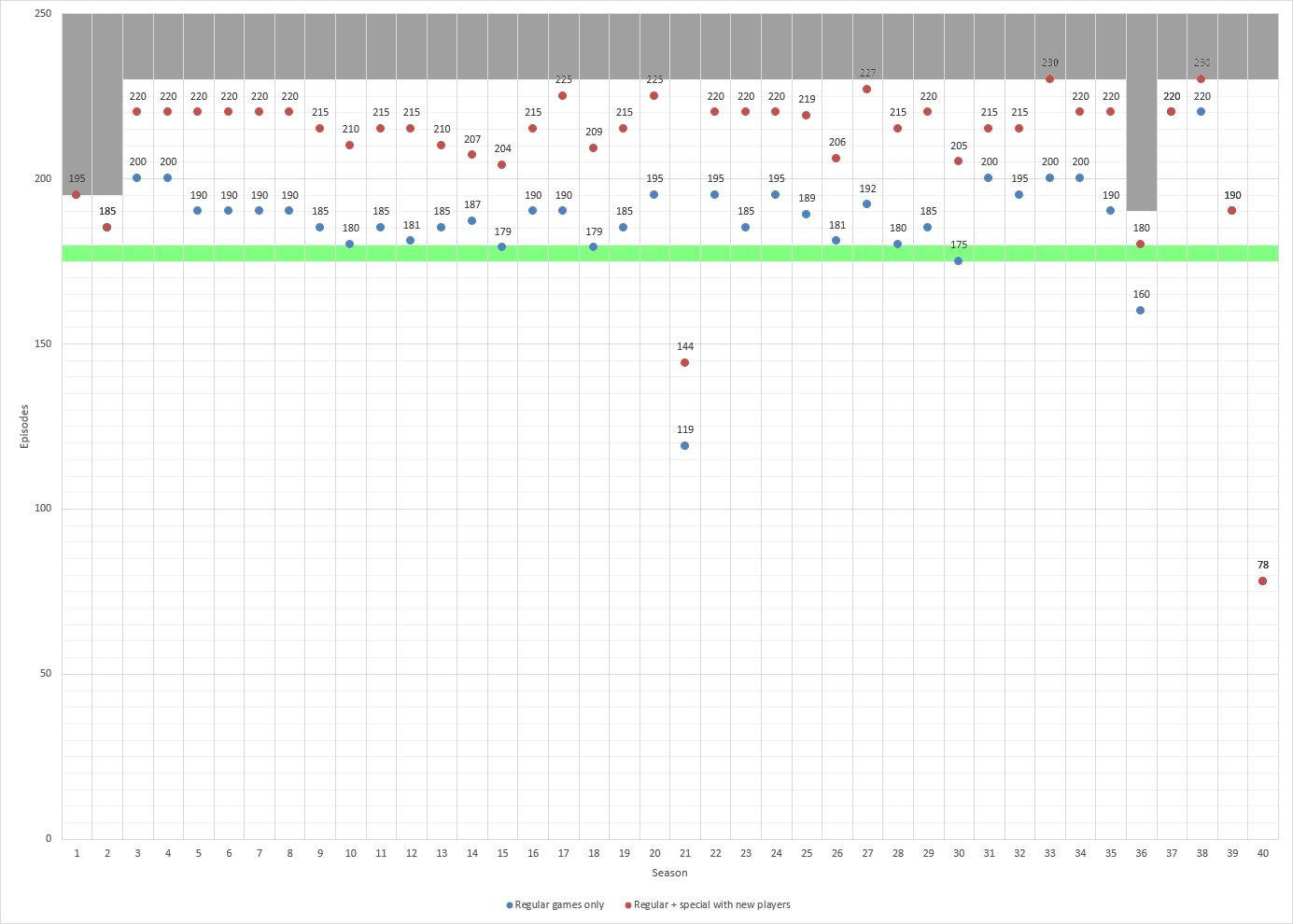Thoughts on the Upcoming Jeopardy! Postseason
I had planned for this to be a “catch-all” post about several different topics, but having gone sufficiently long on the first of those, I’m leaving the rest for another time.
Here’s what we know about this season’s tournaments
In two recent episodes on Inside Jeopardy!, Executive Producer Michael Davies and Producer Sarah Foss disclosed plenty of information about how tournament play will go down over the middle of this season. On September 23, we learned:
There will be two weeks of Second Chance competition, in the same format as last season and the one before (three semifinals, two-game total-point final) — thus, 18 non-winners in total will return
There will be a single Champions Wildcard competition, advancing its winner to the ToC. In addition to the two Second Chance winners, 13 non-ToC-qualifying champions will compete. (The producers explicitly said that, in contrast to the Season 40 postseason, not every champion will be invited back.) These thirteen will be chosen “by invitation,” that is, at the producers’ discretion; they won’t necessarily be the next players immediately below the ToC direct qualifiers. This will be played over two weeks in the “traditional” tournament format; that is, five quarterfinals, the winners and four highest scoring non-winners advancing to three single-elimination semifinals, and a two-game total-point final.
The “cutoff” for the upcoming postseason was the October 2 taping day, which is Week 13 of the season. The reigning champion on December 6, and everyone competing in regular play between then and the start of the postseason, are eligible for the 2026 ToC in the middle of Season 42.
That was supplemented by Monday’s podcast episode:
There will be three weeks of regular play between the ToC cutoff and the start of the postseason; these are the episodes to be taped on October 28, 29, and 30. Thus, the postseason schedule as we know it so far:
Second Chance: weeks of December 30 & January 6 (tape dates are November 4 & 5)
Champions Wildcard: weeks of January 13 & 20
Tournament of Champions: starts on January 27
Nothing was disclosed regarding how big the Tournament of Champions field will be, nor that of the Jeopardy! Invitational Tournament. But it wouldn’t surprise me one bit to see the formats of each from last year retained — 27 players each, with the ToC having a first to three wins final series, and the JIT final being first to two wins. Were that done, the maximum lengths of the two events would be nineteen and sixteen episodes, respectively — add those to Second Chance and Champions Wildcard and you’ve got eleven weeks of tournament play. The entirety of the ToC final series would fall within the February sweeps period. It would also wrap up the JIT no later than Friday, March 14, which would keep it clear of March Madness preemptions on CBS affiliates on Thursday and Friday of the following week (while avoiding getting bumped by the NBA’s Christmas Day games on the front end of the postseason).
If the ToC and JIT formats are carried over from last year, the tentative postseason schedule would look like this:
There’s another benefit of keeping the ToC field at 27, at least as Davies might see it — it mitigates the impact of having to truncate Champions Wildcard. He has already had to walk back his original plan of bringing back every previous champion; a maximum size ToC field reduces the number of winners who won’t be returning. That said: with the shortest qualifying period in show history at only 143 games, it’s quite possible we won’t get to 25 3-or-more game champions by early December… would he really seed two-game winners directly into the ToC? As I’ve said before, don’t ever assume “Davo would never” — especially given all the ways he’s already shaken things up (or upset the apple cart, depending on your view).
Some of the reaction a few weeks ago surprised me
Davies and Foss also said on September 23 that there’d be 35 to 36 weeks of regular season play. That struck my ear, as Davies had said back in August of last year that he thought 30 weeks of regular shows was optimal. It certainly felt like a capitulation or concession of sorts to the “tournament fatigue brigade” section of the viewership who complained so much last season. I thought it curious that some of them weren’t placated by that announcement — after all, more than half of the reduction in regular play from the historical average is being restored!1 But there are two dimensions to their continued objections worth considering.
The tournaments will now be in a single, mid-season block, as opposed to being spread out over the season, concentrated on the sweeps periods. Prior to the arrival of Michael Davies, the longest consecutive run of special programming (excluding the Ultimate Tournament of Champions in 2005) was 21 episodes in February and March 1999.
All special play featuring first-time contestants appears to be going away. If there’s 35 to 36 weeks of regular play, and the postseason is 10 to 11 weeks, that covers the entirety of a Jeopardy! season. It follows therefrom that the JIT is considered a part of the postseason, and that the high school and college tournaments previously planned aren’t going forward, joining Teachers on the scrap heap.
On JBoard, Golf made the point that historically, the only times we had returning players were the ToC and the infrequent reunion tournaments. So, I crunched the numbers on special play, breaking it out into three categories: new players, returning players, and exhibition.
Here are the results. And I’ll reproduce here a chart on that page:
The lower row of blue dots plots regular play in each season; the higher row, in red, is regular games plus special play featuring new players, which is what Golf seemed to be getting at. In the case of the latter, except for Season 21 with the UToC, the low in any 46-week season prior to Davies’s arrival is 204, in 1998-99. The green stripe across the graph represents the range of 175-180 games, where Davies wants to put the amount of regular play going forward — with the red and blue dots converging, as all special play will be comprised of returning contestants. All of which is to say that I can see where Golf and others are coming from on this. But I’m still happy that we’re coming up from an expected 150 regular episodes per season to at least 175; it seems to me a well-struck compromise between those who pine for the Harry Friedman-era calendar, and those who think the correct answer to the question “how many tournaments should there be?” is always “more.”
Traditional wildcards return
Davies admitted that, to a limited extent, he gave in on this (that is, advancing high-scoring non-winners). I was reminded of this from a prominent commentator, six months ago:
The fact of the matter is that the old wild card system is a clear thing of the past under the current production team. To be fair: I agree with the show’s stance here—I routinely saw viewers confused online during tournament quarterfinals, some going as far to even trash players for not making cover bets in Final Jeopardy.
… past “wild card” formats are seen as too counterintuitive to the home viewer to be viable in 2024.
Clearly, the show’s production staff doesn’t agree, or the wildcards wouldn’t have been re-introduced. I also thought a few weeks back that if such an objection were made in April, it certainly would have to stand now; that is, that the arguments against wildcards are inherent to the format.
But are they? Particularly, this one about them being counterintuitive — can it be overcome? I think it might be possible. The traditional way this has been handled is to mention the parameters of the format once or twice over the week of the quarterfinals, and then at the end of the Friday game, announce the four wildcard players. Maybe the show should consider bringing over something from Masters — namely, displaying the wildcard standings on screen after Final Jeopardy! in each quarterfinal (or at least, in the first four), much as the match point standings were displayed on screen after every Masters game. Care would have to be taken on this, as those players yet to play their quarterfinals must remain “sequestered” from knowledge of those scores, but I think it’s potentially doable.
Held over to later this week…
My thoughts on the visual changes that debuted on Monday’s episode, and the rumors flying over the weekend about the security of Ken Jennings’s position as host of the syndicated program.
That historical average is 189 regular games per season. It excludes Seasons 1, 2, and 36 (all of which ran less than 46 weeks), and Seasons 21, 37, 38, and 40 (these four seasons were impacted by “black swan” events, and thus had an unusual excess or dearth of regular play).





